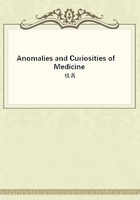
第76章
CLASS II.--Double Monsters.--A curious mode of junction, probably the most interesting, as it admits of longer life in these monstrosities, is that of a simple cartilaginous band extending between two absolutely distinct and different individuals. The band is generally in the sternal region. In 1752 there was described a remarkable monstrosity which consisted of conjoined twins, a perfect and an imperfect child, connected at their ensiform cartilages by a band 4 inches in circumference. The Hindoo sisters, described by Dr. Andrew Berry, lived to be seven years old; they stood face to face, with their chests 6 1/2inches and their pubes 8 1/2 inches apart. Mitchell describes the full-grown female twins, born at Newport, Ky., called the Newport twins. The woman who gave birth to them became impregnated, it is said, immediately after seeing the famous Siamese twins, and the products of this pregnancy took the conformation of those celebrated exhibitionists.
Perhaps the best known of all double monsters were the Siamese twins. They were exhibited all over the globe and had the additional benefit and advertisement of a much mooted discussion as to the advisability of their severance, in which opinions of the leading medical men of all nations were advanced. The literature on these famous brothers is simply stupendous. The amount of material in the Surgeon General's library at Washington would surprise an investigator. A curious volume in this library is a book containing clippings, advertisements, and divers portraits of the twins. It will be impossible to speak at all fully on this subject, but a short history and running review of their lives will be given: Eng and Chang were born in Siam about May, 1811. Their father was of Chinese extraction and had gone to Siam and there married a woman whose father was also a Chinaman.
Hence, for the most part, they were of Chinese blood, which probably accounted for their dark color and Chinese features.
Their mother was about thirty-five years old at the time of their birth and had borne 4 female children prior to Chang and Eng. She afterward had twins several times, having eventually 14 children in all. She gave no history of special significance of the pregnancy, although she averred that the head of one and the feet of the other were born at the same time. The twins were both feeble at birth, and Eng continued delicate, while Chang thrived.
It was only with difficulty that their lives were saved, as Chowpahyi, the reigning king, had a superstition that such freaks of nature always presaged evil to the country. They were really discovered by Robert Hunter, a British merchant at Bangkok, who in 1824 saw them boating and stripped to the waist. He prevailed on the parents and King Chowpahyi to allow them to go away for exhibition. They were first taken out of the country by a certain Captain Coffin. The first scientific description of them was given by Professor J. C. Warren, who examined them in Boston, at the Harvard University, in 1829. At that time Eng was 5 feet 2inches and Chang 5 feet 1 1/2 inches in height. They presented all the characteristics of Chinamen and wore long black queues coiled thrice around their heads, as shown by the accompanying illustration. After an eight-weeks' tour over the Eastern States they went to London, arriving at that port November 20, 1829.
Their tour in France was forbidden on the same grounds as the objection to the exhibition of Ritta-Christina, namely, the possibility of causing the production of monsters by maternal impressions in pregnant women. After their European tour they returned to the United States and settled down as farmers in North Carolina, adopting the name of Bunker. When forty-four years of age they married two sisters, English women, twenty-six and twenty-eight years of age, respectively. Domestic infelicity soon compelled them to keep the wives at different houses, and they alternated weeks in visiting each wife. Chang had six children and Eng five, all healthy and strong. In 1869 they made another trip to Europe, ostensibly to consult the most celebrated surgeons of Great Britain and France on the advisability of being separated. It was stated that a feeling of antagonistic hatred after a quarrel prompted them to seek "surgical separation," but the real cause was most likely to replenish their depleted exchequer by renewed exhibition and advertisement.
A most pathetic characteristic of these illustrious brothers was the affection and forbearance they showed for each other until shortly before their death. They bore each other's trials and petty maladies with the greatest sympathy, and in this manner rendered their lives far more agreeable than a casual observer would suppose possible. They both became Christians and members or attendants of the Baptist Church.
Figure 31 is a representation of the Siamese twins in old age. On each side of them is a son. The original photograph is in the Mutter Museum, College of Physicians, Philadelphia.